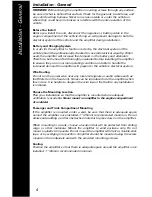
T
u
n
in
g
T
h
e
A
m
p
lif
ie
r
-
S
u
b
w
o
o
fe
r(
s
)
9
Tuning The Amplifier - Subwoofer(s)
4) Lowpass Crossover Control
Experiment with the crossover point settings while the subwoofer is active.
A higher setting will increase the perceived output, and a lower setting will
make the bass response more omnidirectional. Since the Lowpass cannot be
disengaged, set to 15Hz if using an outboard processor or electronic
crossover on the headunit.
5) Q-Tune
™
Control
Once the highpass crossover point has been determined, use the Q-Tune™ control
(refer to the diagram on page 3) to increase the bass information centered around
the highpass crossover point.
Setting the Q-Tune™ control is done in conjunction with setting the levels on the
input sensitivity and highpass crossover (subsonic) frequency controls. You may find
while setting the Q-Tune™ that over-excursion may be detected in the subwoofer (s);
lowering the Q-Tune™ input sensitivity or raising the highpass crossover point will
eliminate this. Minor adjustments to each setting are required to fine-tune the sys-
tem.
Setting the Q-Tune™ is a subtle process. It is recommended that the Q-Tune™ set-
ting be left in the 0.7 position and adjusted only after the input sensitivity and
highpass crossover ranges are known. Small adjustments to the Q-Tune™ setting
are all that are required to fine-tune the system.
6) GTA-RSL Subwoofer Output Control
The optional remote level control (GTA-RSL) gives you independent level adjustment
of the subwoofer’s output level beyond the standard system volume control. Please
refer to the GTA-RSL’s manual for installation instruction. The GTA-RSL is available
separately, please consult your authorized Boston Acoustics dealer.
Connection Diagram:
akers - 80Hz Highpass
s 35Hz Highpass, and Q of 1.2
Summary of Contents for GTA 1105
Page 1: ...High Performance 5 Channel Amplifier GTA...
Page 11: ...Notes 11...






























